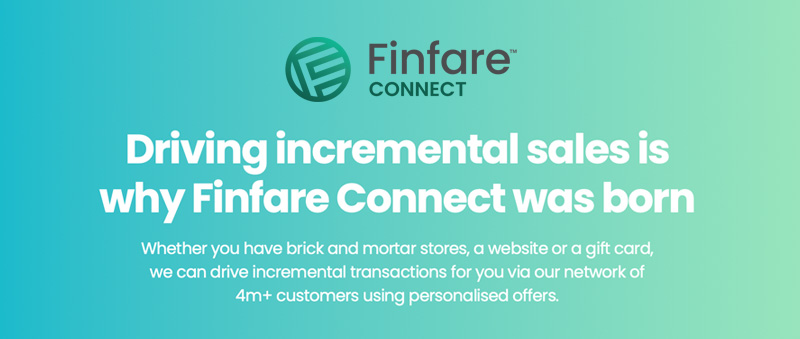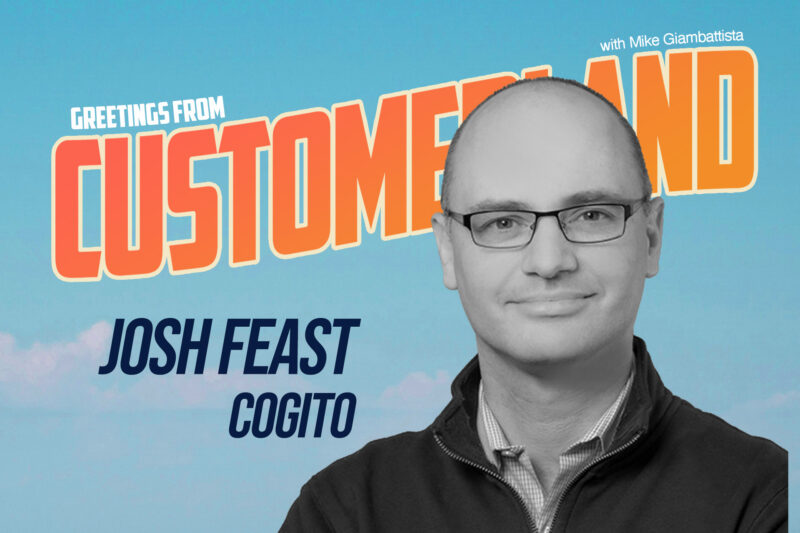In this episode of Customerland, we sit down with Josh Feast, CEO and co-founder of Cogito, to discuss the significant role of AI in transforming enterprise contact centers. Our conversation covers the journey of Cogito from its early days at MIT to its current role in enhancing customer service through the analysis of psychological states and providing real-time guidance to agents. We delve into how Cogito is improving the efficiency and effectiveness of customer service in large organizations.
We also explore the broader implications of AI in sales and customer support, examining how it complements human intuition and enhances decision-making through the analysis of real-time data. Our discussion with Josh offers valuable insights into Cogito’s business model, the scalability of AI technologies, and their application across various industries.
The episode concludes by looking at the future of business communication and the integration of AI into technology ecosystems, focusing on its potential to improve both customer and employee experiences. We touch on the importance of strategic investments in AI and preview a future discussion on the impact of AI technologies like lane departure warning systems on safety. This episode provides a professional and insightful look into the evolving landscape of AI in business.
This episode of Customerland is sponsored by

Read the full transcript below
Mike Giambattista
Josh Feist is CEO and co-founder, rather, of Cogito, which is a really really interesting series of AI based applications informing the CX world and also the HR world. And so first, josh, thanks for joining me. I really, really appreciate it, but I’m hoping you can do a better job of describing what Cogito does than I just have.
Josh Feast
Oh, mike, thank you, and it’s a real pleasure to be here. Thank you for hosting. So Cogito is a real time guidance system for enterprise contact centers. So what does that mean? So that means is the system that will help agents while they’re speaking on the phone with customers and will help them prove their relationship and their emotional connection with customers on the phone as well as guide them through workflows.
There’s more efficiencies. That’s sort of one piece. The next is it helps supervisors and team leads support those agents understand what’s going on with interactions, manage coaching and coaching plans. In addition to that, it provides value to operational leaders in terms of helping understand what was the customer experience, how to boost things like revenue per call or CSAT per call. It also helps operation leaders understand the employee or the agent experience. Not every conversation that happens between a customer and an agent is nice for that agent and you can kind of get ahead of that and then support those agents of things and not as easy for them. And finally, we support what you think was the learning and development part of the organization. So a big part of what the tool does is it will increase the speed to proficiency of new hires who join a large enterprise contact center.
Mike Giambattista
So, if I may speak boldly, everybody’s got an AI based something right now and I think I’m looking forward to the time when, when the world shakes out a little bit and we can actually discern what’s valuable and what is just. You know, I candy, but having interacted with you and your team and seen some of your materials, it sure seems to me like the Cogito proposition is purpose built, to add. It would be silly to say add value, but to add some, some critical value to conversations that have the potential to make or break customer relationships and employee relationships, for that matter. That’s me editorializing wildly, so hopefully you’ll correct me if I’m if I’m out there, but can you talk a little bit about how Cogito goes about doing that? But I think maybe even just as interesting as the journey from where you were to where Cogito was kind of first conceived, founded, and where it is now, because this isn’t the kind of thing you come up with over a beer, or maybe it is, but there was probably a lot more that went into this than that.
Josh Feast
No, thank you very much for asking, and maybe it is good for me to sketch the quick sort of history and then land on the sort of how we do what we do. So I don’t agree. So Cogito is definitely an AI company before it was called. So we’re kind of watching with excitement and amusement as all the hype starts happening. Cogito started over a decade ago. Originally it was a bunch of basic science at MIT where my co-founder, sandy Pentland, who’s a professor, had done this really amazing research showing how you could train a computer to read human psychological state from behavior. That was kind of like the core, kind of really fundamental basic science. I got excited about it. I came in at MIT and I got excited about the research because I had prior work experience where I’d seen how difficult it is to manage a large kind of human oriented organization where your job is to interact with customers or clients and you can’t use the sort of management techniques that you do to build a car, for example.
I really have to think about it differently. Like, the quality of interaction really matters. In some ways that’s a major output of what you are doing is a customer focused organization, but typically you haven’t made a measure of that very well. That’s a great example and certainly you haven’t made a coach or drive to those outcomes traditionally. So I thought, wow, if this could go from basic science to an actual technology and then to a product, wow, we can really make an impact into a huge part of sort of human endeavor. So then it was a journey of love, of course.
We went from basic science to applied technology and to do that we were sponsored by the National Institutes of Health and also DARPA, which is the high tech funding arm of the DoD. But the reason we were funded and this is interesting is because at that time there were a lot of soldiers coming back from Iraq and Afghanistan with distress issues PTSD, depression, various things like that. So we were funded in order to take our technology and come up with a way to automatically understand and measure psychological distress in vulnerable populations. So we worked in healthcare as a result for a very long time and we continue to work in various capacities government healthcare as well and so from there we basically started working to help nurses with no interacting with patients likely patients with long-term chronic disease to recognize distress and basically what you think of as co-morbid depression, which is basically, if you’re also depressed, you’re looking after yourself, you can’t look after yourself as well. So you’re trying to detect that and then apply extra help to people. And of course, in doing that we realized that actually there was another way we could look at this which was even more interesting, which was we could help the nurses with their phone-side manner when they talk to the agents, how to become more engaging. And then, if you’re more engaging, you could help people support their healthcare more effectively.
And then within those, we started working with large health insurers. Then they say to customers they said well, it’s great you’re doing this over in this clinical part of the world, why don’t you do it in customer service? And I go, we could do that. And so we just started working in customer service and so we were totally working in all these different parts of these large organizations. And then sort of the predictable thing happened Salesforce came along and some others said this is a really cool one. I hope we find you and help you grow and be a water-based enterprise, ai company, and so that’s what happened. So we since raised venture capital and now we service organizations across tech, telco, hospitality, obviously, healthcare insurance and also North America and now in Europe, and so that could be a little bit about journey, yeah.
Mike Giambattista
A wild ride for sure, especially since you were doing AI before. Anybody else was really thinking in those terms. Now the whole world is wondering, you know, which kind of puts you in a unique position to actually understand the potential of technology.
Josh Feast
So that’s right, and the limitations, which I think is also really important to understand, because that speaks to like application design.
Mike Giambattista
I would love to talk about that a little bit too, because I think the way the marketing public is thinking about AI right now, it’s literally a sky’s the limit. I wonder if it can make my fill in the blank, and very few people are talking about its limitations in any other way than say I think a growing concern is about biases, misuses, those kinds of things, but you’re in a very good position to be talking about what it can’t and shouldn’t do, so I’m still very, very interested in talking about what Cogito does in the marketplace, because the applications here are vast, as you now know, and I’m just now learning. But do I understand this correctly and I’m probably I’m going to be? If this is a dumb question, I’ll edit it out. But so does Cogito do what it does just based on voice signals, or are there other signals that the technology is interpreting beyond that?
Josh Feast
So what Cogito does from a sort of a data perspective is it’s receiving a streaming voice conversation between two parties or multiple parties, and then what it’s doing is it’s looking at how the parties are speaking and interacting, which gives which is sometimes referred to as a motion AI.
Basically, it’s really pulling information about what you can think of as your non-verbal signaling. It’s also looking at what the parties are saying to each other and guiding those things, and so then what the agent is receiving while they’re speaking on the phone are basically in-call visual prompts that are queuing them to adjust how they speak and what they say, to drive efficiency, effectiveness and experience. So it’s kind of like the core of this and a nice metaphor for the tool is you think about your guidance in a modern car? Right, you think like lane departure warning? Right, you’re driving your car and if you’re, the kids are screaming in the back and you’re going to drive off the lane, you’ll get a little nudge to stay in the lane. So it can help, you know, really save you. In the same way, it can help save a conversation Interesting, and if you’re in the light and everything’s good, then there’s nothing to do, right.
Mike Giambattista
That’s a really interesting way of doing it. I was part of a test cohort this was probably about three months ago, maybe a little longer From an AI-powered basically sales person the company was developing. It was looking for people who were more or less objective and could evaluate the effectiveness of the bot having a conversation with me, trying to sell me something, and what was remarkable to me was that it effectively read my pauses and hesitations and seemed to respond really, really well to all of it, which takes an enormous amount of processing power to reach back, read what those signals have meant historically, and then processes in real time to deliver in-the-moment responses that are meaningful. I was completely blown away, and it sounds like you’re doing similar things for agents, for employees, for nurses, throughout. It was just wild.
Josh Feast
That’s right. One of the things that you’ve got these applications, they have the design of how you interact with the user. That’s obviously critical that way that delivers AI strengths and also manages its limitations, as we’ve mentioned. Then you’ve got the models themselves and you hope that they’re really robust and in some ways, magical. And then you’ve got the computing system and it’s a huge part of what we do. We have customers. We were deployed on over 30,000 agents all receiving real-time, in-the-moment feedback, and it has to be a few tens of milliseconds. For example, if I rudely interrupt you and I’m going to get a little cue to tell me not to do that, I suggest I don’t do that. If that happens 10 seconds later, it’s too bad. You’re already offended.
It really has to be there. It’s like you’re laying the patch, you’re running in a conversation in a drive. You can’t be late on that. So that’s exactly right that this issue of compute and efficient compute, because you’ll see it can do this in acceptable cost becomes a critical hidden capability.

Mike Giambattista
As CEO, I get to ask CEO-related questions about the company overall, where you’re trying to take it, et cetera. You’ve mentioned a handful of different spaces and verticals that you’re playing in deeply. Are there places that you are not quite playing yet to your full desire? Capacity where you would like to be? Where do you see Cogito’s technology and ability being deployed in your future that it’s not now?
Josh Feast
Well, that’s an excellent question. I think about, first, the components of what we’re trying to do. We want to have guidance, want to have really good coaching, want to generate really good insights and also support compliance. We also want to really deliver quality. Those four pillars are, from a product perspective, where we think a AI guidance system is going to need to be. Those are the things that we think it needs to do. We have all of those pieces, some very well-built out, some a little bit earlier, but everything is there.
Where we’re excited right now is we have now a long-standing commitment to service and a lot of success in driving improvements and service in a whole range of verticals. But some of the most recent data we have is now really a valid ability to improve sales Not just service the sales, but pure sales. For us, there’s a very big expansion. It took a lot of work to get there. The first couple of times I tried it we didn’t succeed. Now we’ve really got it to a point where it really makes a difference. We can build trust, we can manage the workflow, we can drive up so cross-sale in very highly regulated environments with very stringent customers at large scale. I’m very, very excited about that. I’m also excited about two other things. One is international, an international expansion, because we have had some really nice successes in Europe and in the Americas, which have been wonderful to see the system really perform in multiple languages with multiple cultures. It worked in the lab and now we know it’s working well. I’m really excited about that.
The last thing is traditionally Cogito has been an organization that serviced really large companies only. One of the reasons is we couldn’t really figure out how to service smaller companies economically. We just couldn’t figure out how to do it. We mentioned the cost of compute and everything that’s required to do this. But now we’ve got the assistant to the point where we think we can start servicing what we think of as that mid-market enterprise. We’ve taken on a couple of customers judiciously to make sure that we can do it. But that’s really good, because there should be what happens with these technologies right, very large companies can afford them. First because they can deploy them at scale and sort of amortize the cost over the large scale. Then, as the technology delivery costs, we start becoming more efficient. We can start opening it up. That’s only got to be a good thing. I’m really thrilled about those three elements.
Mike Giambattista
Really exciting, yeah. For a small to medium-sized mid-market business to be able to even think that they could afford anything like this is a pretty wild consideration. For a lot of people, that’s a really big deal. Your international expansion also really exciting, are you? It’s hard to get it. Again, this is more of like business process and model questions rather than the technology. But is Cogito driven mostly by a kind of a direct sales model as opposed to kind of a partnership? Or maybe you’re embedded as a white label component into other technologies, or is it all of the above?
Josh Feast
We’re largely direct sales, which reflects our sort of traditional business model of working directly with large enterprise customers, so it’s sort of the traditional way to do it. Now that we’re starting to get our toes wet in the mid-market, we’re trying to work more closely with partners, with some significant success actually. So I’m pretty excited about that, although for us it’s still relatively early days comparatively. We aren’t white labelling our technology, not something that we have an aversion to, it’s just focused. That being said, it’s quite common for customers when they want to deploy Cogito, they may have their own single pane of glass on the desktop, and so our technology is an integrated part of the overall sort of agent or supervisor and ops leader and L&D quality team like dashboard, and so we encourage that. That can be really nice to just have this sort of guidance. It should be part of the whole. It’s not, but you can deploy Cogito separately and that works absolutely fine. But that is also a really nice approach we found for UI UX.
Mike Giambattista
Also. This would be much better conversation over a couple of beers, clearly, but the you know, everything you’ve described about Cogito seems to me to make you a very, very, very ripe acquisition target for somebody. And it’s none of my business, necessarily, and you probably can’t go into it in detail in this forum, but do you envision Cogito being a kind of standalone entity over the course of its life, or is there? Can we even talk about that at this point? So you know what are your views.
Josh Feast
Well, it’s an excellent question and I think you know, with respect to Cogito, both are possible. But I think that the bigger question is like, if you think about Cogito just in terms of the category that it represents, the category of products, this kind of real-time guidance system, I think it’s when you think about an enterprise, sort of enterprises stack right, what is the right thing? Do you think an enterprise? You think that you think the AI guidance system, which in a lot of ways, is like the intelligence, that’s right, that’s helping support the people Do you think that should be part of Ethereum stack? Do you think that should be part of a telephony stack? Do you think it should be part of, I don’t know, like a web-force optimization stack? It’s not clear, right? It’s not clear.
There’s a case to be made that your AI guidance system should be its own layer and have it interact with any of the other layers that you want, and of course, that’s what Cogito does.
It has integrations to all the major players, because of course, we have to have that to function. So I can see it sort of both ways and you know, if you’re a vendor that sells the Ethereum stack or the telephony stack or any of the other stacks, you can see why you want to potentially also deliver the AI stack, which is where almost certainly a lot of the value is going to come right. And you know, and we do see that with your players that are dominant in those other layers, you know, and it’s been around longer, they all you know developing AI features at a frenetic pace because there’s not, there’s not, there’s not a surprise right, that that’s sort of the case. So I think it’s an interesting question, sort of aside from Cogito, about kind of what is right, but I definitely think there’s a case to be made that kind of the quote-unquote AI intelligence layer is its own layer.
Mike Giambattista
It’s going to be fun to watch and see how that kind of manifests itself out there in the marketplace. I’m aware of some statistics that I’d love to talk with you about. There’s an apparent conflict, I think, out there brewing that you’re probably in a great place to comment on, but here I’ll just pull this one straight out here Over half of consumers prefer to chat with a live agent via phone, compared to 17% who prefer technology communications. Yet SurveyMonkey Workforce Survey, 72% of respondents who use AI recognize that automation significantly increases productivity. So there’s a bit of tension in there. I don’t think this is necessarily binary. It’s not a winner-take-all. There’s probably a complex series of sliding scales, but how does that get worked out? Human interaction will always have value. So, anyways, let me not project and I’m just going to listen to you. How do you think through?
Josh Feast
that. How do I think about that? Look, excellent question. The model. I basically used the following model. I tried to simplify it in my own mind. I used the following model it basically says that there’s service and then there’s self-service and then not the same thing.
The difference is that with service, you take the monkey off your back, you give it to another human and they sell the problem for you. It’s not like an emotional experience as well as a practical experience. With self-service, you’re given tools and you sell the problem yourself with the tools that are made available, so they’re not good or bad. I think where the confusion comes is when you have self-service, mass grading as service, and then people are like oh and. Every time in my experience that people make that mistake, they end up in the wrong place and with the promise of, for example, of a theoretical chatbot that can do everything a human can do. That’s really something we should have to blur those lines, and mostly people have been disappointed by that, but they haven’t been disappointed when it’s been used really for what it’s capable of doing, which is really a self-service tool. That’s the mental framework I use, and so then when you go from that and say, well, what’s going to happen in the future. So the way I I’ll first of all just tell you what the data shows up to now.
The data shows up to now is that the economy grows. Also, everybody gets richer, so that they all want service. Because everybody wants service. Everybody wants somebody else to take care of their problem. Right, of course they do, I do, you do, you really do right, we have to better afford it. But people are getting richer over time and the economy is growing over time, so the demand for service is always increasing.
However, self-service tools also increase, and that what we see is, just like healthcare costs, the demand for service keeps going, but it bends the curve, it stops it from getting exponentially larger. Because you’re continuing to invest in self-service technologies, and we’ve been doing this since the mail of a catalog, right? So that’s how I think, it’s how I kind of look at it, and so so Cogito has focused its efforts to date on enhancing we can think of as self-service. I should not say the technologies can’t be used for self-service, but that’s where we focused.
And so what you see on that survey just to kind of get back to that is we see that consumers are continuing to want service. When they want service, they’re increasingly becoming very comfortable with the idea that that service is going to be enhanced by AI behind the scenes, like they’re very, very comfortable with that. We also see that agents this is a huge change in the last couple of years, like causing agents are actually demanding AI assistance because it’s part of upskilling themselves and being ready for the workforce of the future. So that’s wonderful. And then I think we see good success with self-service tools as well, as they’re framed appropriately and not framed to be something that they can actually do.
Mike Giambattista
In my role here, our role here at the customer we interact with a lot of people in the CX space and increasingly in the EX space HR and, as I mentioned the beginning of our conversation, there’s literally everybody has some AI powered, some gadget Gizmo, you know, bell or whistle and I almost think that right now, in this, in today’s environment, it’s a necessity.
If you’re not talking about that, people wonder why, but I know that some of these companies have invested ungodly sums of money into developing large language models that power certain aspects of their platforms and suites, and some of them are quite sophisticated and really, frankly, cool. But I don’t see anybody and I could be completely wrong here, but I haven’t seen in my work anyone who is pursuing AI driven conversational analysis if that’s what it is with the kind of emotional sentiment component that you guys have seen developed really, really well, and it makes me wonder did they just not know about Cogito? Or is it just so easy and cheap to start developing your own large language models and the algorithms that power the AI and machine learning behind them that it was just like, well, we’ll just do this and then we own it, rather than licensing something existing and amazing like what you have?
Josh Feast
I think you’re right that there are very few organizations that specialize in what you can think of as the emotion AI part of things, and one of the reasons is that kind of a different technology. There’s a lot of signal processing and there’s a lot of kind of complex integrations. Actually, it’s hard, it’s like hard. That’s the problem. It’s a hard thing, and I think that the excitement around large language models was as well justified was the fact that you basically can take a machine learning model and I know this and find that and trade it on the internet and then turn it into a whole bunch of text. What is there not a whole lot of voice conversations? And also voice conversations are typically from a sort of societal perspective. We treat them very carefully. We don’t like our conversations out there. We want to know that conversations are being recorded, and we should. It feels very close to us, our voice feels very personal to us, whereas the words we use is something external. So there’s a little bit more of a more difficult set of data to work with. So I think that’s part of it, and then I think the other part of it is the kind of emotion AI, what we think of. You have to have good science behind it. The reason I got excited about getting in this field is because we had really strong basic science showing that this wasn’t like wasn’t going to be sort of like something that doesn’t work or doesn’t have like a really good framework or really good sort of psychological basis, like a basis in like how humans work, rather than sort of a basis in how statistics work, and I think is also sort of why this is a little bit more of a challenging area.
And then I think the last part is that this is where we’ve gone to as an industry, so you don’t start it off really focusing on only on emotion, ai, and then it’s expanded as technologies to include conversation and generative and all that. But really where the frontier is now what they think of as multimodal, which is how do you really combine all this? What we do because you know we refer to it just because it doesn’t, we prefer this as really what you want is context aware guidance. You want the guidance that you’re giving to take into account everything that’s going on. So you know, like, take a trivial example right, if we’re going to say, if the right thing in the workflow is to this attempt to upsell, cross, sell somebody on this other product. Let’s do that at a good point in the conversation, where the customers receptive to that and they’re not. It’s not going to be perceived as rude or like. Why are you asking me that?
Mike Giambattista
Right right.
Josh Feast
This other thing right, like you know, say this is the sort of thing I have like some concept of the emotional context, and then you’re going to be much more successful and much more efficient and it’s going to be much sort of a better experience for everybody. That’s what we mean and that really kind of orchestration and the fusion together is really that sort of fun frontier right now in my opinion.
Mike Giambattista
I would like to refer you to a large US drugstore chain that I interacted with yesterday. That had no sense of context whatsoever. It was just like and this is a big company that’s got a lot of money and you’d think, just try just a little harder. So I hesitate to name them, but think of one of the two bigger drugstore chains in this country and you’ve nailed it. Think of receipts that are usually about six feet long.
Josh Feast
You don’t really make a sport coming on that. So there’s another part to this, about almost why Cogito exists. And one of the reasons Cogito exists is also that humans are perfect. So we talk about how humans add a lot. The AIs look at limitations. Humans add a lot. They work better together because humans have a model of the world and AI has stats. So that’s why they work so well together. But humans also have limitations.
One of the big ones that, you see, is a human will get something called compassion fatigue. So an agent will do 30, 40 calls a day. Not all of them are easy. Some of them may be repetitive. And what happens in your brain is you, after a period of time, your brain becomes fatigued so you literally don’t detect the social signals of the person you’re talking to. It’s not that somebody’s ignoring you. They may not literally realize that you’re frustrated, but in particular by the time. So that’s what we think about this lane departure warning kind of concept. I don’t need it if I’m like focused and I’m just had a coffee and it’s a good time for me in the morning, but if I’m distracted, I’m tired and something’s happening in the backseat, then I need it and I think that’s the kind of the point of these systems and why this kind of symbiosis can get a better outcome.
Mike Giambattista
It’s going to be a fun. Well, frankly, the next six months are going to be really interesting to see what else the business world starts to focus on here as we start being able to focus on it, but even more so where Cogito is going, because it seems like you are the I’m overstating this clearly, but you have the dog by the tail here somewhat. You’ve really kind of created so much of what other people are leaning into just yet. So if you’re willing to open up your schedule again in another six, nine months or so, I’d love to. I’d love to see if we could continue the conversation. Talk about amazing. Yeah, I would love it. I think the people who listen to this podcast and read our material are all vitally interested in this topic. So so, yeah, if you’re willing, I’m, I’ll have my people get in touch with your people. As they say Amazing.
Josh Feast
I look forward to it. That’d be fantastic.
Mike Giambattista
Well, Josh Feast is CEO and co-founder of Cogito. It’s been an enlightening conversation and I cannot wait for the next time we get to do this.














